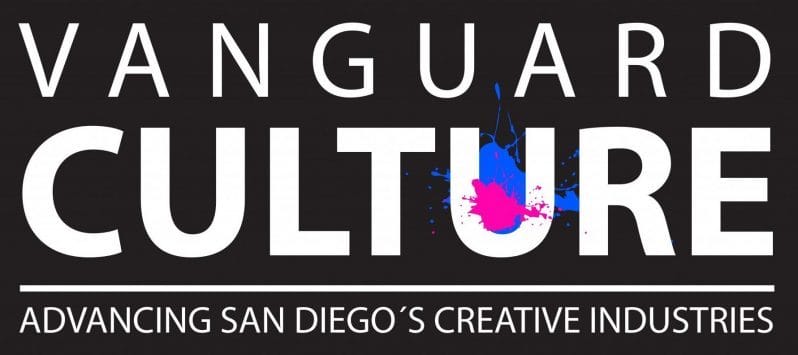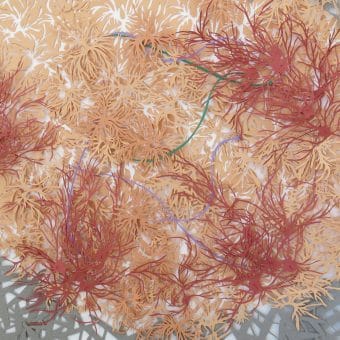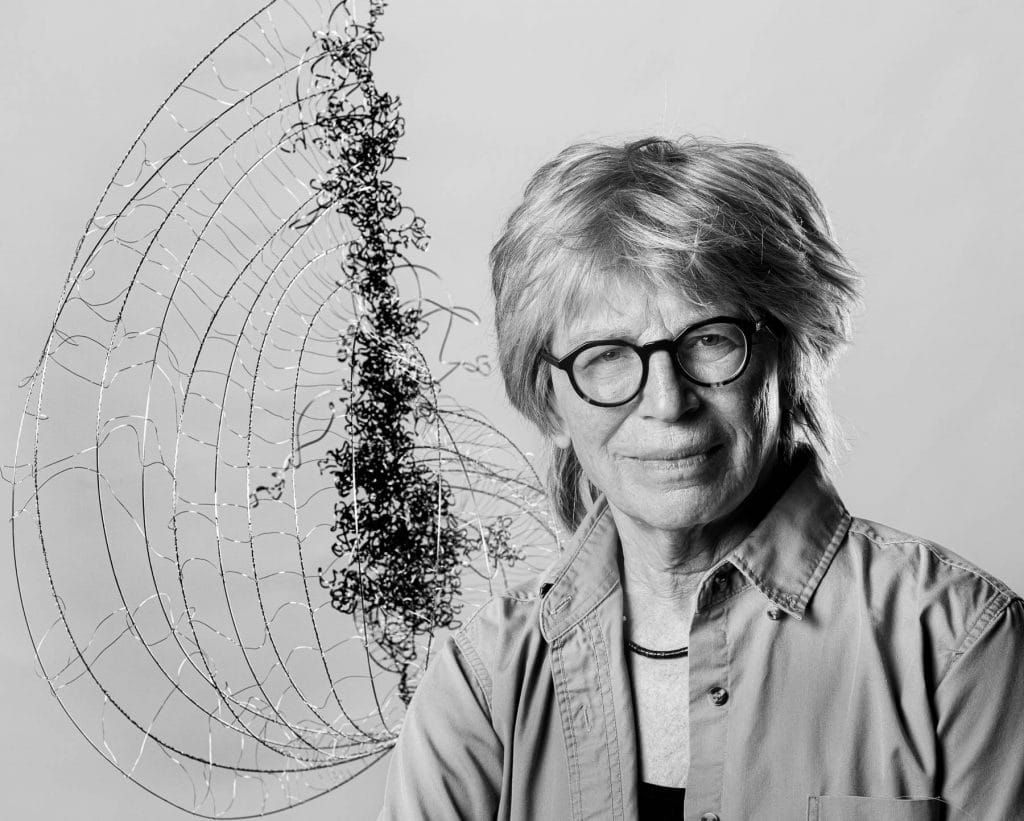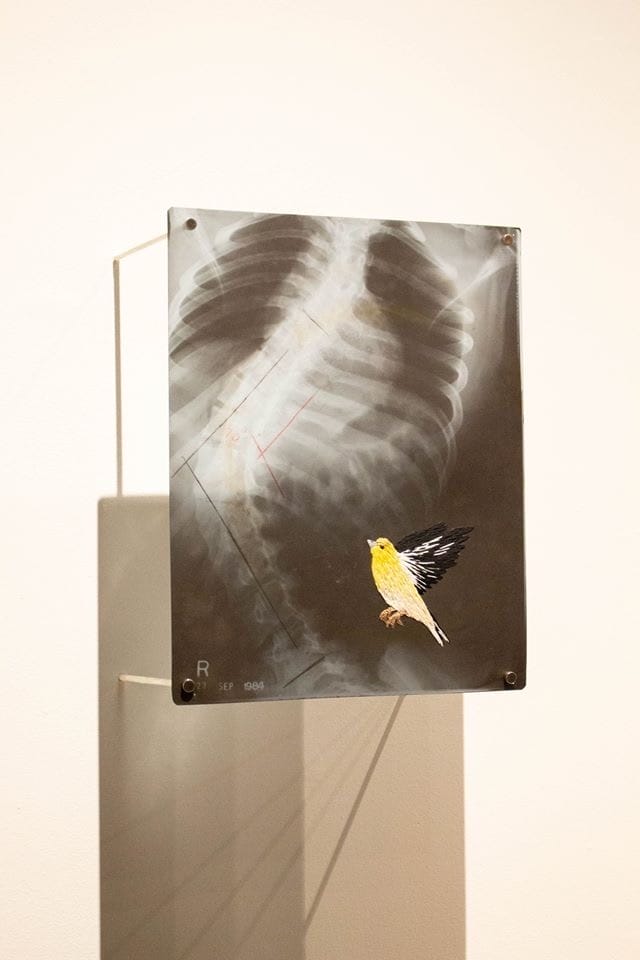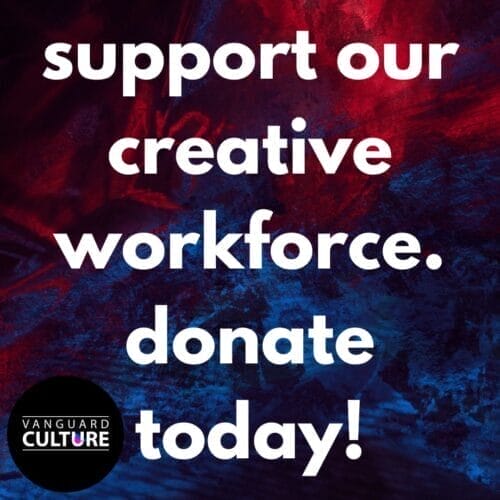By Rebecca Romani
February 12, 2020
Many scientists describe their work with adjectives normally reserved for beauty while some artists seek the precision of mathematics or digital images. What might happen, then, when Science, Technology, and Art come together?
In San Diego, one of the most vibrant international hubs of cutting edge scientific research and technological development, surrounded by a number of innovative artists, quite a lot, it turns out.
That thought becomes a reality in “Illumination,” an intriguing and gorgeous show currently at the San Diego Art Institute in Balboa Park.
According to SDAI Executive Director, Jacqueline Silverman, “Illumination” is the opening act in a group of dynamic shows intended to showcase local and regional art, and aiming to position the SDAI as a top contemporary art space in the San Diego/Tijuana and Los Angeles regions.
Silverman sees “Illumination” as sitting at the intersection of art, science, and technology, using “these interconnected fields to boost public understanding of contemporary issues and explore solutions, both real and imagined.”
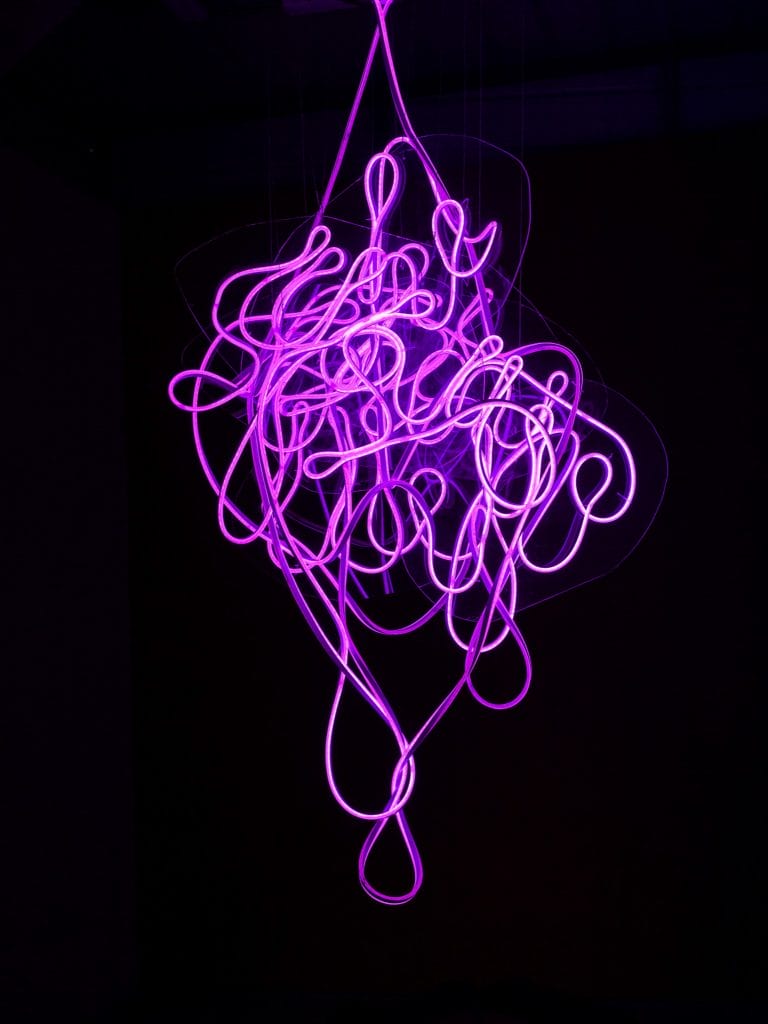
The core of the show, curated by Chi Essary, Vanguard Culture board member and artist/curator, is made up of 16 pairs of accomplished local artists and leading scientists in their fields from prominent local entities La Jolla Institute for Immunology, Qualcomm Institute/Calit2, Salk Institute, Sanford Burnham Prebys Medical Discovery Institute, Scripps Institution of Oceanography, Scripps Research, and UC San Diego.
Ten other artists, brought in by SDAI, round out the idea of the three pillars the larger show is based on, Art, Technology, and Science.
Essary, who also currently curates the San Diego Art Prize, draws upon her vast networks both in the scientific community and among artists to bring together a diverse group who represent, in Essay’s words, “two sides of the same coin.”
The result is an exceptional show of thought provoking, visually stunning artwork and installations laid out beautifully in the ample space.
Almost everything is here, from DNA to motor neurons, cancer to addictions, missing limbs, and much in between. It’s a veritable what’s what of living organisms, interpreted in thread, paper, wire, clay, and more.
Among the more surprising pieces is video artist Cy Kuckenbaker’s installation, Chromosome 22, based on his interactions with Zbigniew Mikulski at the La Jolla Institute for Immunology. Kuckenbaker was particularly taken with what he saw through the microscope at the Institute’s lab and equally fascinated by the amount of code that makes up Chromosome 22, one of the smallest chromosomes in the body. Chromosome 22 is a clever send up of a classical library nook with the video from the microscope suspended like a portrait above a huge book open to almost the precise middle- thousands of pages of the chromosome’s code. Behind it all is brightly colored, patterned wallpaper Kuckenbaker designed himself. Stand back and it looks like Mexican oilcloth, come in close and the pattern becomes repeating images of the scientists working in the lab.

Anne Mudge by Paul M. Bowers 
Image by Tim Hardy Photography
Another installation that looks at DNA is Anne Mudge’s hanging interpretations of DNA packed into nuclei. A multi-media artist, Mudge spent time with Ferhat Ay of the La Jolla Institute for Technology, to create delicate but powerful hanging sculptures of genomic architecture. For Mudge, who describes herself as “long been fascinated by the astonishing architectures built out of natural processes,” this collaboration produced astonishingly graceful forms created from wire, quartz, lead weights and pigment. Effectively silhouetted against the wall, two meter wire pieces are coiled in and over themselves, sometimes as a ball, sometimes as a beautiful shell created along the Fibonacci sequence.

Spinal cross section detail.
Artist Bhavna Mehta
Artwork by Bhavna Mehta
Shadows and self-knowledge inform the works created by Bhavna Mehta and Akiko Surai. Mehta, whose rise to prominence with intricate cut-paper installations has been swift, worked with Samuel Pfaff of the Salk Institute on a project of particular interest-how the spinal chord is affected by injury and disease. Stricken by polio as a child, Mehta’s resulting piece, Fault Lines, is deeply personal. Mehta uses hundreds of pieces of colored paper, pinned in place with 700 pins to create a 20-foot cross section of a spinal chord, complete with labels of color-coded sections such as the motor neuron. The cross-section “magnified 200 times,” according to Mehta, is a striking piece, acquiring an almost mandala-like serenity as it sits, echoed by its own shadows. To the left of the installation, an x-ray of a convoluted spine, Mehta’s own, plays host to a cheerful yellow embroidered bird. Mehta, who was deeply touched to work with a scientist in this manner, included the x-ray because “it exposes the fact that the story of your life is written on your body.”
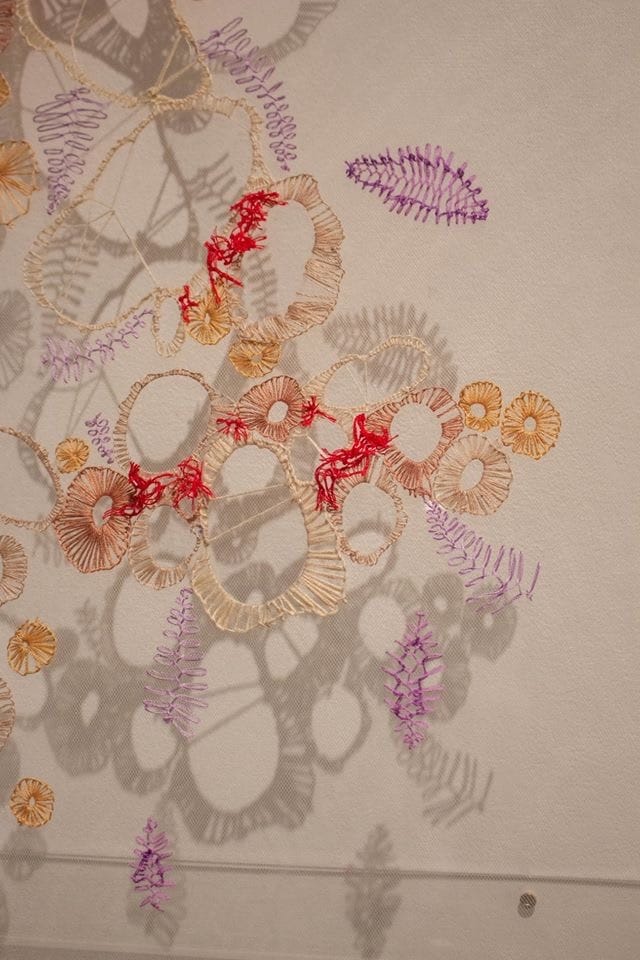
Surai’s work, Untitled (after Vadodaria), inspired by her time with Rusty Gage and Krishna Vadodaria of the Salk Institute, is an assortment of delicate open circles embroidered in different colors across a mesh suspended on an acrylic panel and hung so that the shadows enhance the stitching
The circles do not so much interlock as they sit in semi-connectedness, trying to close gapes in the mesh, much like a physically compromises brain tries to restructure its pathways. The Gage Lab’s work of repurposing skin cells into elements like neurons is echoed in the varying embroidered circles which seem to reach out to each other in an attempt to create and repair networks, much like the Gage Lab’s work on brain cell dysfunction. For Surai, who has had to try multiple solutions to chronic pain, the Gage Laboratory’s work appeals to her because “Instead of calling my brain cells resistant to treatment, it would start with my experience as a standard which I think helps retain a degree of agency in a really dehumanizing process.”

More is Sheena Rae Dowling’s fascinating response to working with Olivier George on the brain and addiction. As someone who has struggled with addiction herself, Dowling said she was deeply affected by George’s work that demonstrates how an experimental compound can shut off the powerful perpetual cycle of withdrawal, offering hope to those working through substance abuse. “Seeing his research felt so validating of the struggle I went through and gave me deep gratitude for my recovery,” said Dowling. More, housed in its own room, is an intricate interplay of metal mesh and fiber optic cables, glowing with various colors and patterns- much like a healthy brain. Dowling invites the visitor to press a button- and see what withdrawal might look like. It’s impressive and not a little bit disturbing at the same time.
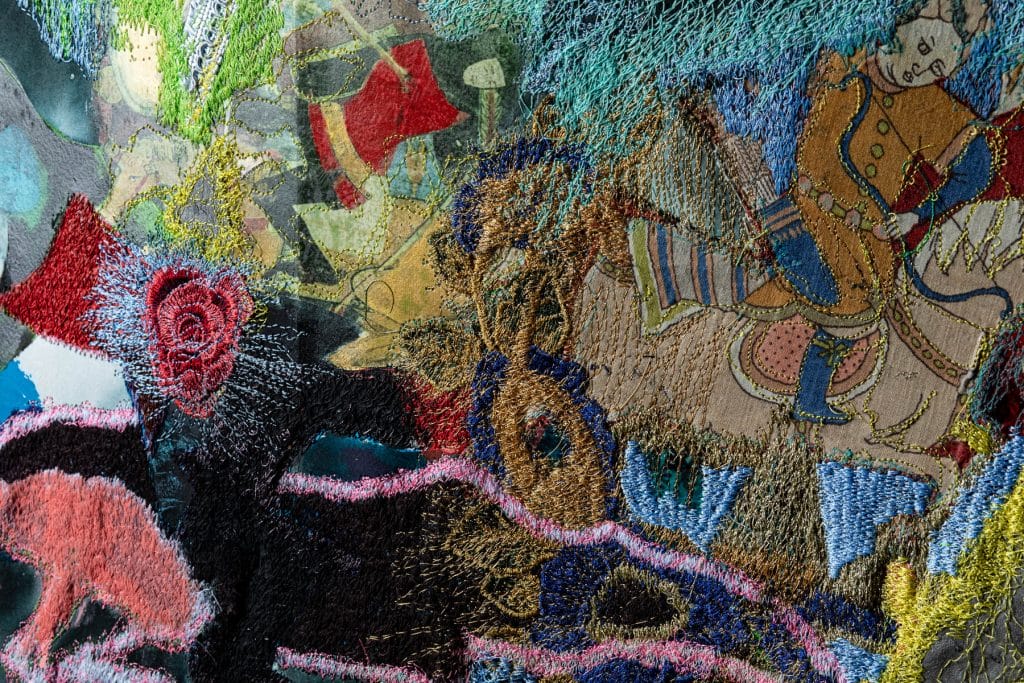
The collaboration of artist Griselda Rosas and renowned researcher Dr. Ramachandran of the Salk Institute, has given rise to one of the more interesting metaphors of the show. Rosas’ response to her discussions with Ramachandran on his research into the phantom limb syndrome and shared interests in issues of colonization is Rasa, a multi-layered panel of thread, fabric with Mughal horsemen, Christian religious iconography, and human figures. Here Rosas channels the idea of the missing limb into a complex meditation on what happens to societies like India when colonization by others disrupts the progression of the original culture. Similarly, the idea of the phantom limb is the perfect metaphor for decolonization as well when the colonized loses his/her link with the past and the colonizer experiences the loss of the land that once was theirs.

Photo by Paul M. Bowers
The show also includes a number of interactive pieces that challenge the viewer in numerous ways. For example, the sound artist Margaret Nobel’s pairing with the La Jolla Institute for Immunology results in a Dogma Roulette, a robustly made game table that encourages the player (s) to examine their assumptions around food, life styles and diabetes. It’s an astonishingly detailed piece, down to its chips, one that will keep you thinking for a while.

Photo by Paul M. Bowers
And then there is William Feeney’s work, suspended from the ceiling. Fascinated by sharks and how humans re/act with them, Feeney takes foam, paper, and paint to new levels with his Great White. “Our fear of sharks feeds the idea that sharks are bad, and we should be afraid of them. On the other hand, research tells us that large sharks are critical to the balance and maintenance of healthy oceans, and they pose very little danger to us,” said Feeney. The result is an impressive, muted pastel-colored Great White, think the shark from “Jaws” – turned inside out, even the massive teeth.

Artwork by Hugo Heredia Barrera 
Maternal Source by Dia Bassett
Photo by Paul M. Bowers
Other fine pieces also populate the show from Hugo Heredia Barrera’s giant wire and glass vision of a cancer attacking a cell to Dia Bassett’s Maternal Source, a slip and robe covered with various materials representing the biome of the body. Beliz Iristay, the Turkish-American artist whose blues recall Ottoman Turkey, also looks to the body- but in silence, investigating how the deaf use and process American Sign Language. Her installation, Building, uses clay bricks with ALS hand impressions on one side and her characteristic blue patterns on the other.
Nature itself is not far from certain of the pieces. Jason Lane uses a 90-ton press to marry Thale Cress, a weed often used in experiments, with heavy rag paper- “ennobling it,” he said, inspired by antique manuscripts. For artist Alexander Kohnke, the metaphor is the mouse- or more specifically, the remains of the mouse. Fascinated by the power of magnification, Kohnke takes pictures of the contents of owl pellets and enlarges them in his four part series, Cross Hatch– a disconcerting yet riveting take.

Photo by Tim Hardy Photography
Becky Guttin’s fine installation- Clean, Dust, Dirt– also uses metaphors- a tree, used aluminum-to examine Alzheimer’s stealthy progress through a brain while Jim Murdoch’s amusing Just Nod If You Hear Me, turns to the tree as a metaphor for body parts trimmed with little birdhouses that ring as you pass, echoing neural activity. Micro becomes macro as Justin Manor looks at transistors in Finfet, which turns transistors into miniature pieces of architecture.
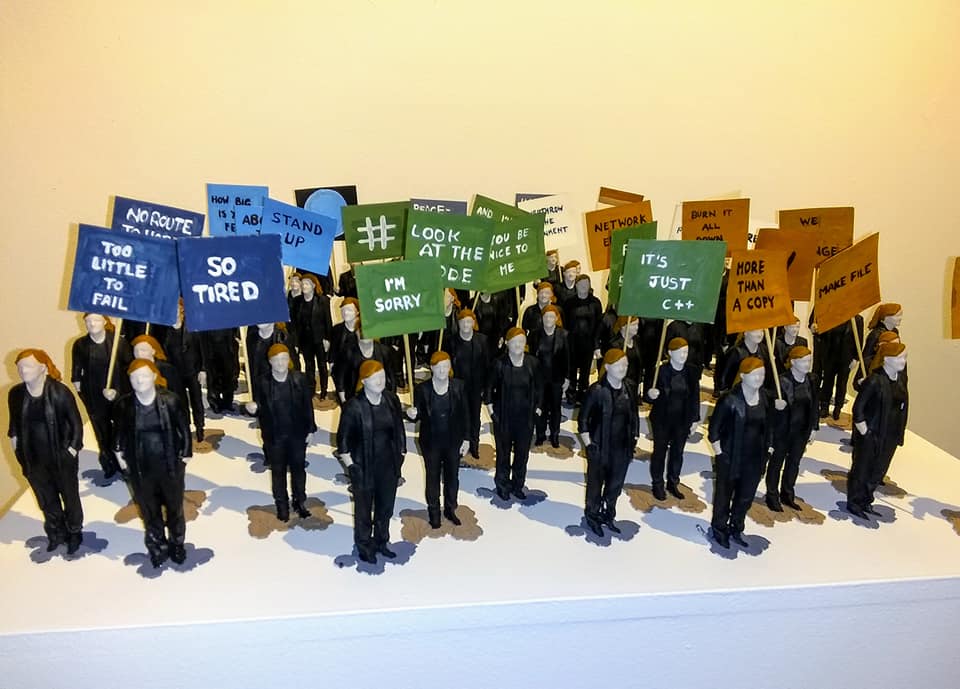
Photo by Paul M. Bowers
According to SDAI Executive Director Silverman, SDAI chose to add 10 more artists to “round out the show,” and to add more diversity. Situated mostly on the periphery, the work, sans scientist is interesting if not quite in sync with the rest of the core pieces. Among works of note is Trish Stone’s installation, a collection of Little Trishes protesting, (as well photos of them protesting in front of various places in San Diego à la the gnome in Amélie) and two engaging video games. John Burnett’s soundscapes add an interesting dimension with three distinct sound compositions designed to compliment each of the three pillars around which the show is constructed. Lean in and you’ll hear some evocative combinations.
Los Angeles-based LGBTQ+ artist Young Joon Kwak casts a regional cachet over parts of the show. Her Brown Rainbow Eclipse Explosion hovers over the descending staircase, looking like a close cousin of the Star Wars Death Star, creating beautiful shadows while her meditation on pronouns and surveillance glows over a vaginal reflecting pool.
“Illumination” is in residence at the SDAI until May 3, 2020. A generous grant from the Legler Benbough Foundation allows visitors to come in for free.
Please see the SDAI website for times and other associated events HERE.
